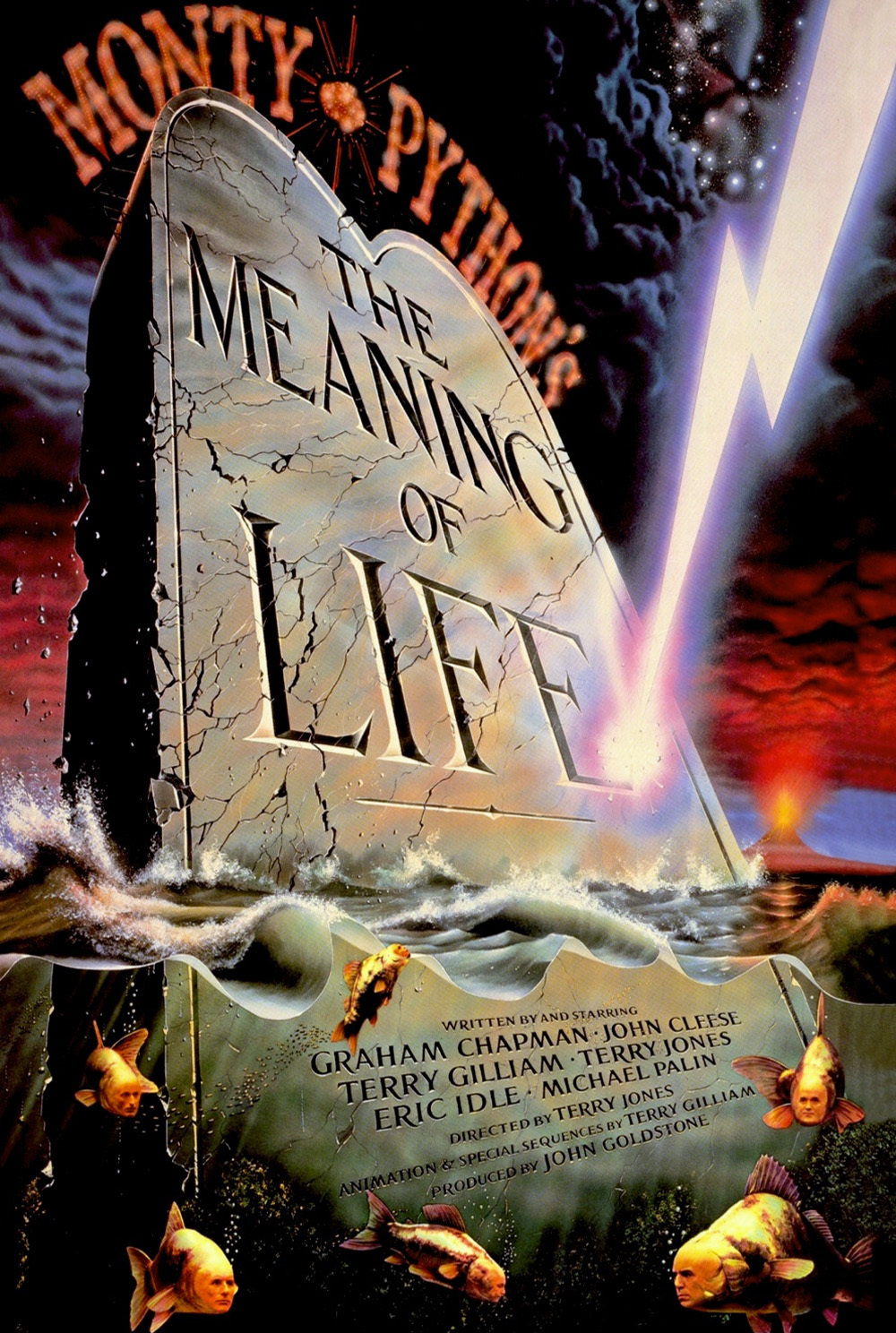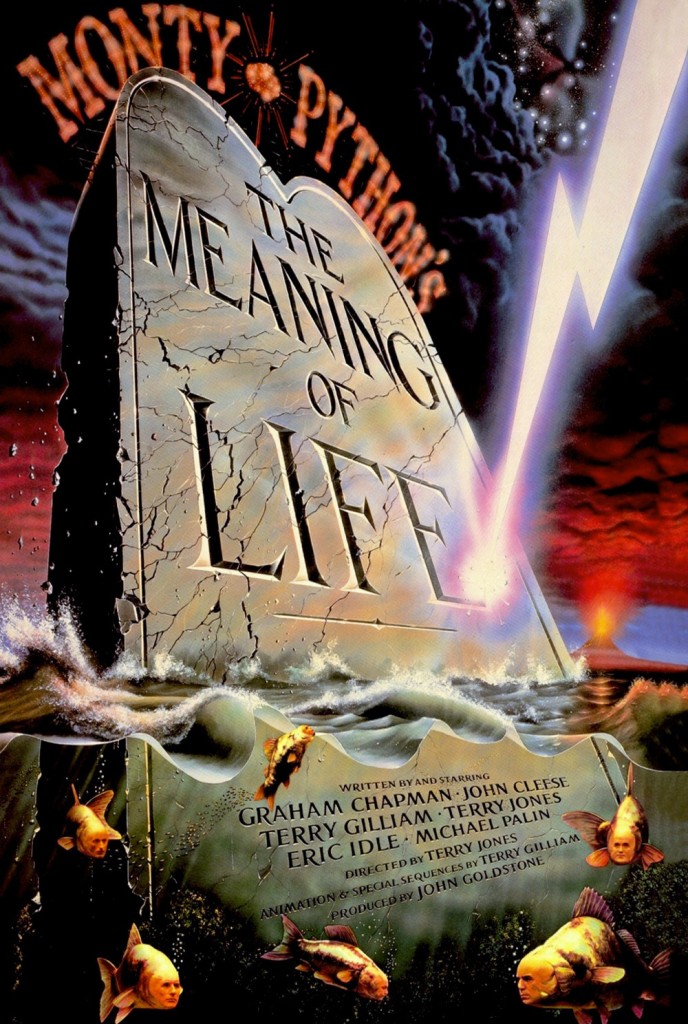“There’s everything in this movie, / Everything that fits. / From the Meaning of Life in the universe, / To girls with great big tits. / We’ve got movie stars and foreign cars, / Explosions and the lot / Filmed as only we know how, / On the budget that we’ve got. / We spent a fortune on locations / And quite a bit on drink / And there’s even the odd philosophical joke, / Just to make you buggers think. / Yet some parts are as serious / And as deep as you could wish / But largely it’s all tits and ass / And quite a bit of fish. / Other bits are fairly childish / And some are frankly rude / But at least we’ve got a lot of nice girls / All banging around in the nude. / So take your seats, enjoy yourselves / And let’s just hope it’s funny / Because it’s not only done to make you laugh / But to make us lots of money. / So sit back and have a good time / With your boyfriend or your wife / Relax and just enjoy yourself / For this is the Meaning of Life” (Idle, 2009)
Last week, I overviewed existentialism, and this week JustHeath is going to follow-up a bit from this topic (along with a slight nod to a recent posting by LKAwesome). One of the central questions to existentialists, people, and—apparently—Fish is “What’s it all about?” Well, the British comedy troupe Monty Python took on this topic in their 1983 classic film The Meaning of Life. If any readers are unfamiliar with Monty Python, its primary members are Graham Chapman, John Cleese, Terry Gilliam, Eric Idle, Terry Jones, and Michael Palin. Some of these names may be recognizable in other contexts. The group originally had a BBC series called The Flying Circus, but then they made films and a Broadway musical. To Americans, they are probably most famous for Monty Python and the Holy Grail, but it’s certainly possible they are most infamous worldwide for The Meaning of Life. WARNING: Spoilers ahead.
Prologue
The above poem from Eric Idle is the original sales pitch they used to get funding for the film, and that was apparently the entirety of the solicitation (Idle, 2009). It is read live in the DVD version of the film as a prologue.
Short Feature Presentation: “The Crimson Permanent Assurance”
Terry Gilliam, the only American Python, was originally only supposed to do his typical animations in a short intro to the film; however, he went way over his budget and shooting time to create this masterpiece satire of massive corporations of the modern age and the farcical financial system.
The Crimson Permanent Assurance – Video Dailymotion.
Feature Presentation: The Introduction
The actual film is introduced by some of the freakiest fish you’ll ever see. They pose the question for the premise of the film, and then this opening animation commences:
Part I: “The Miracle of Birth”
The opening sketch takes place in a hospital, and it’s definitely a critique of the modern healthcare system involving HMOs and hospital administrators and the like. There’s a great line from a doctor to a woman giving birth: “Now, don’t you worry. We’ll soon have you cured.” What a great allusion to pregnancy being a disease of parasitism. In “Part 2: The Third World,” of this section, there is a great lampooning of the Catholic Church, and I have often wondered what Father Jim Morrison thinks about this sketch. It takes place in Yorkshire, and it is essentially a musical bit about a Catholic father having to sell his children for scientific experiments because he can no longer afford to feed them all. I counted 64, but I suspect I missed a few due to a scene cut. There’s also a Protestant preaching the virtues of prophylactic devices.
Part II: Growth and Learning
There are again quite a few pokes at organized religion in this section that takes place in a Catholic school for boys. There’s also quite a graphic sex ed lesson that does involve some partial male and female nudity. It ends with a great transition to the next section that sort of compares sports to warfare.
Part III: Fighting Each Other
I’m still a bit confused by this section as I would have expected it to be a response to the ridiculousness of humans killing each other. Well, some of that is present in it, but it seemed more a satire on the British class system (particularly in the military). However, there is a poignant line during the Zulu war scene in which a soldier states, “I killed 15 of those buggers, sir. Now, at home, they’d hang me! Here, they’ll give me a fucking medal, sir!”
The Middle of the Film
I think this is quite possibly one of the most bizarre scenes/interludes/intermissions in all of cinematic history. I’ll just say that fish are involved again.
Part IV: Middle Age
This scene mainly involves poking fun at American tourists, but there is an actual “conversation” about philosophy.
Part V: Live Organ Transplants
This could be one of the grossest things in film at the times of its release, but fortunately not much is shown. There is probably more meaning in Eric Idle’s “Galaxy Song” shown in this section that most of the rest of the film. It definitely is existential in theme:
Part VI: The Autumn Years
This bit begins with a short song dedicated to a certain male member, and then there’s a gross depiction of gluttony. In Part B of this section, the meaning of life is named and expressed by a waiter whose mother told him to “love everyone, try to make everyone happy, and bring peace and contentment everywhere you go.”
Part VII: Death
One of my favorite scenes in all of Monty Python begins this section which involves a most unique method of execution. In my opinion, this part is also the most pythonesque in scope. There’s a great visual of Death and a landscape, and the Grim Reaper is invited to dinner. It ends with a great tie-in with most of the characters in the whole film watching a production of “Christmas in Heaven.”
The End of the Film
A presenter describes the true meaning of life: “It’s nothing very special. Uh, try and be nice to people, avoid eating fat, read a good book every now and then, get some walking in, and try and live together in peace and harmony with people of all creeds and nations.” Also very pythonesque, the closing credits keep with the fish theme and hint at more meaning:
“The Producers would like to thank all the fish who have taken part in this film. We hope that other fish will follow the example of those who have participated, so that, in future, fish all over the world will live together in harmony and understanding, and put aside their petty differences, cease pursuing and eating each other and live for a brighter, better future for all fish, and those who love them.”
Reference
Idle, E. (2009). Eric Idle: The meaning of life poem. Retrieved from http://www.montypython.net/scripts/EI-meaningpoem.php

